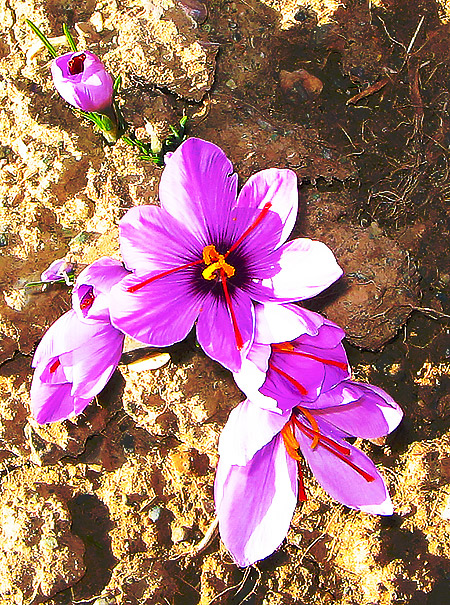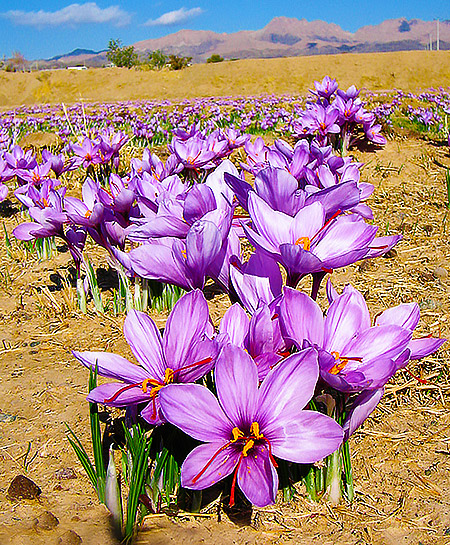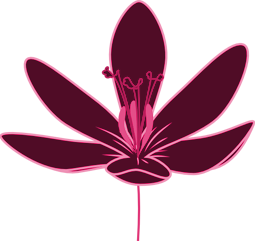Cultivation and Harvest Saffron
Cultivation
As saffron needs little water, the south borders of Khorasan province- due to the specific ecological conditions- are suitable regions for this plant. Although it has been cultivated in other conditions and regions, neither the quantity nor the quality of the product succeeded to benefit the owners.
Before harvesting and processing the counting unit for saffron is bulb and its quality depends on the level of color and fragrance.
![]()

Saffron usually grows in climates which have warm and dry summers and almost gentle winters.
The suitable soli for cultivating saffron is level sand and clay.
It is better to cultivate saffron after fallow or rotation season. The best fertilizer is animal heap and its land should be flat. Saffron is cultivated in the second half of September. 3 to 10 tons of saffron bulbs are needed for each cultivating hectare land.
Saffron is watered by whirlpool method. The first time watering of saffron farmland is at the last days of September.
After the land is dried, it is shallowly ploughed; remembering not to hurt the bulbs. It will soften the level soil which covers the bulbs and helps the plant to continue growing. In fact, it lessens the soil compression to help the first leaves and then the stem of the plant to shoot out.
The second watering phase is after harvesting the flower. The land needs 2 to 3 times watering before the spring and one to 2 times in the spring. From the second month of spring and due to the high temperature, the prick 10079 leaves of plants become yellow and sometimes are used as food for domestic animals.
Harvest
![]()

Saffron harvest starts 10 to 15 days after the first watering phase simultaneous with flowering time. Necessary to know that the saffron flower shall be picked before the sunrise and before the sun radiation affects the flowers; otherwise, the flower as well as the saffron quality will fade.
Maybe on time harvesting in iran is the reason for better quality in comparison to the others. Not long after they are picked up, the tiple stigma and the connected style should be separated from the flower which consist the main product.
By considering all the aspects, it will then be basically packed and presented to the market.
One of the most important differences of Iran ‘s with other countries ‘saffron is the organic cultivation and identified growth process in Iran. It carries the benefits of thousands of process in Iran. It carries the benefits of thousands of years experience from the farmers who first cultivated this wonderful plant in Iran plateau.
In Iran, chemical’ fertilizers are never used in saffron lands. Because though they may help the plant to grow better, they will certainly hurt the soil and the plant itself from other aspects. This is another reason for higher quality and health of Iran saffron. Dr. Ghorbani who is one of the featured lecturers of International Saffron symposium held in Iran has also confirmed these points.

“Sargol” saffron, as referred to before, is the same as “All Red “ product exported to Australia. It is certainly the fine packing which has brought the credit to New Zealand as “Sargol” saffron producer. That is why the title of “A11 Red “ is practically interwoven only to the name of NewZealand country. However, “ Allen Zitta “ confesses that the outstanding difference between lran’ s and the other countries saffron is the existence of quite various species with unlimited diversity. Khorasan saffron ranks the highest among the other regions in Iran.
The product amount has direct relation with soil fertility and the farm land lifetime. The product will not be too much in the first two years .
But it will reach its maximum in the 5th and 6th years.
After 8 years the production of the land will have a considerable decrease.
ln these situations, the old bulbs shall be cultivated in another land. Statistically speaking, in general conditions 10kgs saffron can be gathered from each hectare farmland.
Saffron is among few product s which aim and end of a farmer through all his hard and continuous effort – is just a “ flower The nature manifests its grace and beauty tuough a flower the nice petals and sepals which in the hands of fanner have more spirituality than other fruits or products. From the moment of picking the flower, it begins to fade and wither. So, it is important to detach the stigma and style very quickly and carefully. Therefore, by losing time, the petals and sepals will rapidly become more faded and this will cause problem while detaching them from the flower and will al so cause decay and losses. It will result in exposure of saffron in the sun radiation, moisture and heat and unqualified saffron.
A farmer once said: “It is unsatisfactory for me to pick the flower, set the petals and sepals aside and detach the stigma and the style but I am happy to understand what is presented to people by picking the heart of saffron and how its good fragrance takes out all the tiredness from them”. Drying saffron is one of the most important parts of the production chain. Since centuries before, fanners cultivated saffron, spread the final product in the sunshine exposure and dried it.
They didn’t know sunshine damages saffron badly. After a long time and development of agricultural sciences, it was proved that the sun radiation is harmful. There are many methods for drying this product the bases of which are alike. They all pay attention to light and heat. Saffron may be taken away from light but shall be heated to become dry.
After drying the product, the same conditions shall be continued in order for saffron to have long life. In other words, saffron shall be kept away from sunlight & remain dry. Returning moisture to saffron causes
fungi on it.



